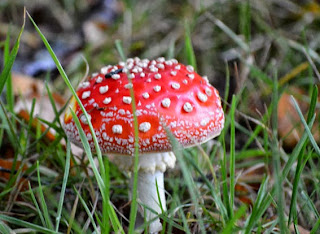Whilst walking around Trentham woods and gardens it was clearly very Autumnal with the leaves of some trees spread across the ground. However, not all of the trees were shedding leaves yet, so clearly this is not going to be a spectacular autumnal year for tree colour. However, the fungal fruiting bodies are out in profusion.
This is a Shaggy ink cap, sometimes called a lawyers wig (Coprinus comatus). It erupts as a long dome and eventually curls up to expose an ink like fluid from the gills.
One of the most well known and quite poisonous species is the Fly Agaric (Amanita muscaria). This is a small example and the domed head of the fungus can be as broad as an outstretched hand.
Common on the forest floor is Inocybe umbrina or perhaps I. napipes. Distinguishing this species is not so easy.
One of the most charming fruiting bodies is Mycena galericulata. This fungus was hidden in the darkest part of the woods and needed to be photographed using flash. These are often called fairy bonnets, as are many other similar species.
On a tall tree, covered in large fruiting bodies of a fungus that I could not identify (may have been a Phyllotopsis species) I saw this small bundle of Gymnopilus sp.
In the mown lawn at the side of the River Trent were patches of grass containing Psathyrella gracilis - another species commonly called fairy bonnets. Sometimes these meadow fungi form rings around the outer edges of the hyphae, the filamentous strands of the organism that grow underground, forming a mat of growth just below the substrate surface.







No comments:
Post a Comment